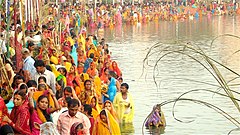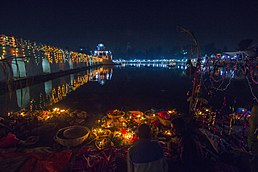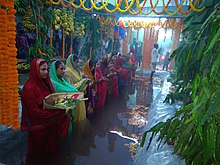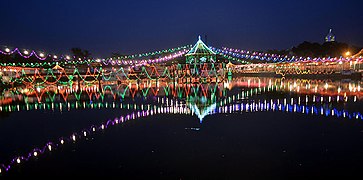Informatics Educational Institutions & Programs
Contents
| Chhath Puja | |
|---|---|
 Devotes gathered together at a pond in Janakpurdham, Madhesh Province, Nepal to worship Surya, the sun god and his sister Chhathi Maiya | |
| Also called |
|
| Observed by | Indians and Nepalese
|
| Type | Cultural, historical, religious |
| Significance | To venerate Surya, the sun god and his sister Chhathi Maiya |
| Date | Kartik Shukla Shashthi |
| 2023 date |
|
| 2024 date | Thursday 7, November |
| Frequency | Annual |
Chhath is an ancient Hindu festival, native to eastern India and southern Nepal.[2] It is celebrated[3] especially in the Indian states of Bihar, Jharkhand, and Eastern Uttar Pradesh;[4][5] and the Nepalese Autonomous provinces of Koshi, Lumbini, and Madhesh.[6][7][8][9] In major Indian and Nepalese urban centres like Delhi, Mumbai, Kolkata, Hyderabad, Chennai, Kathmandu, etc., the diaspora actively participates in celebrating Chhath, preserving their cultural heritage.[10][11][12][13] The festival is also celebrated in countries like the USA, Australia, Singapore, UAE, Canada, Mauritius, Japan, UK, etc., by the diaspora.[14][15]
During Chhath Puja, prayers are dedicated to the solar deity, Surya: to show gratitude for bestowing the bounties of life on Earth and to request that certain wishes be granted.[16]
Chhathi Maiya, the sixth form of Prakriti and Surya's sister, is worshipped during the festival. It is celebrated six days after Deepavali, or Tihar, on the sixth day of the lunar month of Kartika (October or November) in the Hindu calendar (Vikram Samvat), and hence why it is called Surya Shashti Vrata.[17][18][19] The rituals are observed over three nights and four days.[20] They include holy bathing, fasting, and abstaining from drinking water (as a vrata), standing in water, and offering prasada (prayer offerings) and arghya to the rising and setting of the Sun.[21] Some devotees also perform a prostration march as they head towards the riverbanks.[22] All devotees prepare similar prasada (religious food) and offerings.[23][24]


Environmentalists have claimed that the festival of Chhath is one of the most eco-friendly religious festivals.[25][26] Although the festival is observed most widely in Nepal and some Indian states, it is also prevalent in areas where the diaspora and migration from those areas have a presence.
Significance
Chhath puja is dedicated to the Sun God Surya, as it is thought that the sun is visible to every being and is the basis of life of all creatures on Earth.[27] Along with the Sun God, Chhathi Maiya is also worshipped on this day. According to Vedic astrology, Chhathi Maiya (or Chhathi Mata) grants children long life and good health by shielding them from illnesses and diseases.[28]
Description


Chhath Puja is a folk festival that lasts four days. It starts with Kartik Shukla Chaturthi and ends with Kartik Shukla Saptami. Chhath is celebrated twice in a year.[29]
- Chaiti Chhath - It is observed in the Chaitra month of Vikram Samvat.[30]
- Kartik Chhath - It is celebrated at a very large scale in the Kartika month of Vikram Samvat.[31]
Nahaay Khaay (day 1)
This is the first day of Chhath Puja. The Parvaitin (transl. devotees, from Sanskrit parva, meaning "occasion" or "festival") must take a holy bath, after which the entire house, its surroundings, and pathways to the Ghat are thoroughly cleaned. The Parvaitin usually cooks Sattvik Lauka Bhaat (bottle gourd and Bengal gram lentil preparation with Arva rice bhaat). This preparation is served to the deity in the afternoon as Bhog. This initiates the Parv and is the last meal of the Parvaitin during Chhath Puja. The food is then eaten to protect the mind from thoughts of vengeance.[32]
Rasiaav-Roti/Kharna/Lohanda (day 2)
Kharna, also known as Rasiaav-Roti or Lohanda, is the second day of Chhath Puja.[citation needed] On this day, the devotees do not drink even a single drop of water as offer to worship. In the evening, they eat gur ke kheer (Kheer made up of jaggery), called Rasiaav, together with Roti.[33]
Sandhya arghya (day 3)

This day is spent preparing the prasada (offerings) at home, often consisting of a bamboo basket decorated with fruits, Thekua and rice laddus. On the eve of this day, the entire household accompany the devotee to a riverbank, pond, or other large body of water to make the Arghya offerings to the setting sun. The occasion can in many ways resemble a carnival. Besides the devotees and their friends and family, numerous participants and onlookers are all willing to help and receive the blessings of the worshipper.
At the time of arghya, Gangajal water is offered to Surya and the Chhathi Maiya is worshipped with the prasada. After the worship of Sun God, Chhath songs are sung in the night and the Vrat katha is read.[35]
After returning home the devotees perform the ritual of kosi bharai together with the other family members. They take 5 to 7 sugarcanes and tie them together to form a mandap and beneath the shade of that mandap, 12 to 24 Diya lamps are burnt and thekua and other seasonal fruits are offered. The same ritual is repeated the next morning between 3 am and 4 am, and afterward the devotees offer arghya or other offerings to the rising sun.
Usha arghya (day 4)
On the last day of Chhath Puja, at dawn, worshippers travel to the riverbank to offer an arghya to the rising sun. After making this holy offering, parents pray to Chhatti Maiya for their child's protection as well as the happiness and peace of their whole family. After worship, followers participate in the Paran or Parana rite, breaking their fast with a small amount of prasada and water. This rite emphasises the connection between family well-being and divine favours, serving as a symbol of thanksgiving and spiritual closure.
Rituals and traditions
-
Chhath celebration at Gangi River in Arrah
-
Chhath Puja worship material
-
A woman praying during Chhath
-
Women waiting with Prasada for offerings
The main worshippers, called parvaitin (from Sanskrit parv, meaning "occasion" or "festival"), are usually women. However, men also observe this festival as Chhath is not a gender-specific festival.[36] The parvaitin pray for the well-being of their family, and for the prosperity of their children.
In some communities, once a family member starts performing Chhath Puja, they are duty-bound to perform it every year and to pass it on to the following generations. The festival is skipped only if there is a death in the family that year. If the person stops performing the ritual on any particular year, it stops permanently and one cannot resume it. In other communities, this is not mandatory. The prasada offerings include Thekua, Khajuria, Tikri, Kasar and fruits (mainly sugar canes, sweet lime, coconut, banana and many seasonal fruits) offered in small bamboo baskets.[37] The food is strictly vegetarian and is cooked without salt, onions or garlic. Emphasis is on maintaining the purity of the food.[38]
History and associated legends

In Champaran, Bihar and Madhesh Province, Nepal, it is a belief that after leaving Ayodhya, Sita stayed in Valmiki Ashram located on the edge of Narayani River in Chitwan district. During that time she celebrated Chhath Mahaparva in Nepal. Even today, people celebrate Chhath festival with great pomp at Luv-Kush Ghat on the banks of Gandaki river located in Indo-Nepal border.[39]
The Chhathi Maiya is worshipped on the Chhath festival, which is also mentioned in the Brahma Vaivarta Purana. It is said that the Chhath Puja was started in the holy city of Varanasi by Gahadavala dynasty. According to the Kashi Khanda, after Banaras the trend of Chhath Puja started increasing in the country.
It is also believed that, there was an ashram of the rishi Kashyapa and Aditi in the Buxar region. Mata Aditi gave birth to Surya as a son on the sixth day of Kartika. Surya is also called Aditya because he is the son of Aditi. For this reason, Chhath Puja is celebrated as the birth anniversary of Surya and the month of Kartika is considered a holy month throughout the year.[40]
In Munger region, the festival is known for its association with Sita Manpatthar (Sita Charan; lit. Sita's footsteps). Sitacharan temple, situated on a boulder in the middle of the Ganges in Munger, is the main center of public faith regarding Chhath festival. It is believed that goddess Sita performed Chhath festival in Munger. That is why Chhath Mahaparva is celebrated with great pomp in Munger.[41]
According to another legend, King Priyavrata, son of first Manu Svayambhu, was unhappy because he had no children. To remedy this, Kashyapa asked him to do a yajna. Shortly after, a son was born to Queen Malini; however, the baby was born dead. Following the stillbirth, the king and his family were heartbroken. Finding sympathy for the royal family, Mata Shashthi revealed herself in the sky. When the king prayed to her, she spoke, saying: "I am Chhathi Maiya the sixth form of Prakriti. I protect all the children of the world and give the blessings of children to all childless parents." After this, the goddess blessed the lifeless child with her hands, so that he came to life. The king was very thankful for the grace of the Goddess and he worshipped the goddess Shashthi Devi. It is believed that after this puja, this festival became a worldwide celebration.[citation needed]
Chhath has been mentioned in both the major Indian epics. In Ramayana, when Rama and Sita returned to Ayodhya, people celebrated Deepavali, and on its sixth day Ramarajya (lit. Kingdom of Rama) was established. On this day Rama and Sita fasted, and Surya Shashthi/Chhath Puja was performed by Sita. Hence, she was blessed with Lava and Kusha as sons.
While in the Mahabharata, Chhath Puja was performed by Kunti after she (and the Pandavas) escaped from Lakshagriha.[42] It is also believed that Karna, the son of Surya and Kunti, was conceived after Kunti performed Chhath Puja. Draupadi is also said to have performed the Puja for the Pandavas to win the Kurukshetra War. It is believed that Draupadi performed Chhath Puja near a spring in Nagdi village of Ranchi. In this village, Chhath Vratis neither offers Arghya in the river nor in the pond. Chhath Puja is performed near that spring in Nagdi.[43][44]
References
- ^ admin; btnlivecities@gmail.com (8 March 2022). "कार्तिक छठ पूजा 2023 कब हैं | चैती छठ पूजा 2023 कब हैं". BTN Live Cities. Retrieved 17 May 2023.
- ^ Dalal, Roshen (2010). Hinduism: An Alphabetical Guide. Penguin Books India. ISBN 978-0-14-341421-6.
- ^ "Surat 1 lakh to celebrate chhath puja". Jai Bihar. 22 October 2009. Archived from the original on 3 January 2010. Retrieved 14 December 2009.
- ^ "20K perform Chhath Puja". Hindustan Times. 2 November 2019. Retrieved 23 October 2022.
- ^ Publications, Adda247. Ace Banking And Static Awareness eBook (English ed.). Adda247 Publications. ISBN 978-93-89924-52-7.
{{cite book}}: CS1 maint: numeric names: authors list (link) - ^ "Preparations underway for Chhath". kathmandupost.com. Retrieved 23 October 2022.
- ^ Sharma, Dr Pradeep Kumar. Ghraundha 3: A complete children book (in Hindi). Naye Pallav. ISBN 978-81-935124-6-3.
- ^ Staff, India com Lifestyle. "Chhath Puja 2021 Day 1: Nahay Khay Significance, Importance, All You Need to Know About This Ritual". www.india.com. Retrieved 21 October 2022.
- ^ Magazine, New Spolight. "Chhath Puja 2021: History, Importance, And Significance of Chhath Puja In Nepal And India". SpotlightNepal. Retrieved 23 October 2022.
- ^ "Vibrant celebrations of Chhath in Kathmandu Valley". kathmandupost.com. Retrieved 14 November 2024.
- ^ Today, Telangana (17 November 2023). "Hyderabad gears up for Chhath Puja festivities". Telangana Today. Retrieved 14 November 2024.
- ^ Excelsior, Daily (7 November 2024). "Lakhs of devotees offer 'Sandhya Arghya' as Delhi celebrates Chhath Puja". Daily Excelsior. Retrieved 14 November 2024.
- ^ "Chhath Puja 2022, Mumbai: मुंबई में 81 जगह पर मनायी जाएगी छठ पूजा, सुरक्षा के खास इंतजाम - Chhath Puja will be celebrated at 81 places in Mumbai special security arrangements". Jagran (in Hindi). Retrieved 14 November 2024.
- ^ "Chhath Puja goes global, Indian diaspora in London, Dubai and the US soaks in festivities". The Times of India. 21 November 2023. ISSN 0971-8257. Retrieved 14 November 2024.
- ^ "How Chhath Puja Is Celebrated Across The World: Traditions In The US, UK, Singapore & More". Outlook India. 28 October 2024. Retrieved 14 November 2024.
- ^ "A festival not confined to Bihar". The Times of India. 25 October 2017. Archived from the original on 23 December 2017. Retrieved 9 November 2021.
- ^ "Chhath Puja 2016: History, Significance, Dates and Benefits of Chhath Puja, Surya Sashthi". The Indian Express. 4 November 2016. Archived from the original on 5 November 2016.
- ^ Das, Subhamoy (3 October 2018). "Chhath Puja". Learn Religions. Dotdash. Archived from the original on 17 November 2015. Retrieved 16 November 2015.
- ^ "Festivals of India And Nepal - Chhath Festival". aryabhatt.com. Archived from the original on 7 June 2009. Retrieved 9 November 2021.
- ^ Richa (6 November 2016). "Chhath at the crossroads". The Telegraph India. Archived from the original on 6 November 2016. Retrieved 9 November 2021.
- ^ "Chhath rituals bring family together". The Times of India. 24 October 2017. Archived from the original on 24 October 2017. Retrieved 9 November 2021.
- ^ Sah, Jitendra (8 November 2016). "Sun worshippers". The Kathmandu Post. Archived from the original on 11 November 2016. Retrieved 11 November 2016.
Some devotees go to river banks to worship the sun by prostrating themselves the entire distance.
- ^ मानपुरी, सुरेन्द्र (10 November 2018). "Chhath Puja: भिखारी सारी दुनिया दाता एक राम... छठ पर्व में आम और खास सब एक समान". Hindustan. Retrieved 9 November 2021.
- ^ Jha, Jivesh (31 December 2019). "Chhath Puja: The festival of Sun God, cleanliness, equality and fraternity". Lokantar. Archived from the original on 31 December 2019. Retrieved 9 November 2021.
- ^ Tripathi, Piyush (6 November 2016). "Chhath the most eco-friendly festival: Environmentalists". The Times of India. Archived from the original on 11 November 2016. Retrieved 25 April 2021.
- ^ Tripathi, Piyush Kumar (28 October 2014). "Ode to god of green things". The Telegraph India. Archived from the original on 1 August 2017. Retrieved 9 November 2021.
- ^ Uniyal, Parmita, ed. (5 November 2021). "Chhath Puja 2021: Date, significance, rituals of Nahay Khay, Kharna and all about four-day festival". Hindustan Times. Archived from the original on 5 November 2021. Retrieved 8 November 2021.
- ^ "Chhath Puja 2019: History, significance, and why it is celebrated". Hindustan Times. 1 November 2019. Retrieved 18 November 2020.
- ^ "All about Chhath Puja". NDTV Food. Retrieved 26 August 2022.
- ^ "What is Chhath Puja: The age-old tradition of worshipping the God of Sun". Indus Scrolls. 10 November 2021. Retrieved 26 August 2022.
- ^ "Chhath Puja | When, Why & How Celebrate - All Indian Festivals". 26 February 2020. Retrieved 26 August 2022.
- ^ "Chhath Puja 2020 Date and Time: Know about the date, days and time of Pratihar sashthi". Jagran English. 16 November 2020. Retrieved 18 November 2020.
- ^ नवभारतटाइम्स.कॉम (1 November 2019). "छठ पर्व से जुड़ी ये खास बातें नहीं जानते होंगे आप, इसलिए पानी में उतरकर दिया जाता है अर्घ्य". नवभारत टाइम्स (in Hindi). Retrieved 18 November 2020.
- ^ "Mumbai: No Chhath celebrations on beaches, says municipal body". Scroll.in. 5 November 2021. Archived from the original on 5 November 2021. Retrieved 9 November 2021.
- ^ Karki, Tripti (2 November 2019). "Chhath Puja 2019 | Day 3-Sandhya Arghya | Significance, Puja Vidhi and Mantra". indiatvnews.com. Retrieved 18 November 2020.
- ^ "Men not far behind women in celebrating Chhath". The Times of India. 5 November 2016. Archived from the original on 11 November 2016.
- ^ "Kasar Laddu Recipe: संध्या अर्घ्य के लिए बनाएं कसार लड्डू का प्रसाद, मिनटों में होगा तैयार". News18 हिंदी (in Hindi). 20 November 2020. Retrieved 20 October 2022.
- ^ "'Rasiao-kheer', 'thekua' make for festive platter". The Times of India. 1 November 2011. Archived from the original on 11 May 2013. Retrieved 13 March 2012.
- ^ "नारायणी नदी में छठ महापर्व से जुड़ी है पौराणिक कथा: मां सीता जब वाल्मीकि आश्रम में थीं, तब यहां की थीं छठ पूजा, देखें VIDEO". Dainik Bhaskar (in Hindi). 7 November 2021. Retrieved 21 November 2023.
- ^ "Chhath Puja: कब से शुरू हुई छठ महापर्व मनाने की परंपरा, बेतिया के पंडित शत्रुघ्न द्विवेदी से जानें सबकुछ". News18 हिंदी (in Hindi). 28 October 2022. Retrieved 21 November 2023.
- ^ "Sitacharan Temple." Live Hindustan.livehindustan.com". Retrieved 8 November 2021.
- ^ Service, Pragativadi News (29 October 2022). "Chhath Puja 2022: History, Story, Significance". Pragativadi. Retrieved 22 January 2024.
- ^ "Chhath Mahaparv: द्रौपदी ने इस गांव में की थी सबसे पहले छठ पूजा, आज भी मौजूद हैं निशान". Zee News (in Hindi). Retrieved 21 November 2023.
- ^ "क्या आप जानते हैं? कुंती व द्रोपदी ने भी की थी छठ पूजा -". Jagran (in Hindi). Retrieved 21 November 2023.
- "भारत-नेपाल के लोगों ने एक साथ मनाया छठ पर्व". Prabhat Khabar (in Hindi). 19 November 2015. Retrieved 6 November 2024.
Further reading
- Sharma, S. P.; Gupta, Seema (2006). Fairs and Festivals of India. Pustak Mahal. pp. 26–29. ISBN 978-81-223-0951-5.
- Dhyani, Ashish (30 July 2021). Hindu Festivals-why to celebrate. Fantabulous Publishers India. pp. 133–140.






















